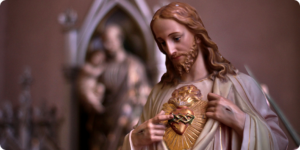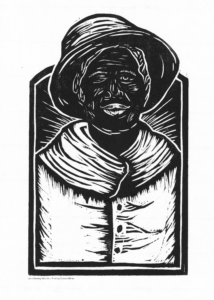The American Eucharistic Witnesses series is published in the Heart of the Revival newsletter and republished by Relevant Radio. It highlights the holy men and women who lived, loved, and served on the very soil upon which we now stand. They all testify—in unique and powerful ways—to what it means to encounter Jesus in the Eucharist and go on mission with him for the life of the world. Old and young, men and women, representing different cultural families and vocations, these men and women show us—in living color—what holiness looks like. We are also thrilled to partner with American artist Connor Miller, who is creating an original woodcut print of each witness to help us visually engage with this creative new series.
Contributed by Fr. Blaine Burkey, O.F.M. CAP.
Servant of God Julia Greeley’s Early Years
The Servant of God Julia Greeley was born into slavery on the farm of Samuel Brice Caldwell, 12 miles west of Hannibal, Missouri. A deacon in the Baptist ecclesial community, Caldwell helped build a small Baptist chapel on his property. There is no information available, however, as to what connection Julia, as a slave, might have had with that ecclesial community.
The sole memory we have of Julia’s life at Caldwell’s farm is her shattered right eye which continued to ooze fluids throughout her life, a violent reminder of the slave master’s whip that blinded her as a young girl. She was ill one day, and her mother stayed back from the field to tend to her. The slave master came after the mother with a whip, and Julia’s eye became collateral damage.
After her emancipation, Julia performed domestic services for the Robinson family in St. Louis, the mother and father of whom are buried in the Catholic cemetery in St. Louis; but again, there is no information available as to what connection, if any, Julia might have had with religion.
Julia moved to Denver in mid-winter 1878 to work for the family of Mrs. Robinson’s sister, Julia Gilpin. We know she developed a close friendship with Mrs. Gilpin, a devout Catholic credited by Julia herself as having “given me my faith.”

Julia’s Devotion to the Sacred Heart of Jesus
Unaware if she had ever been baptized, she received the Sacrament conditionally on June 26, 1880, at Sacred Heart parish in Denver. From then on, she was thoroughly involved in the mission of the Church and became known to the Jesuits who ministered to her as “the most zealous apostle of the Sacred Heart they have ever known.”
Julia died in 1918, on the Feast of the Sacred Heart, a First Friday that year. Fr. Charles McDonnell, S.J., said at her funeral that she was charitable to an astonishing degree and had a devotion to the Sacred Heart, the Blessed Virgin, and the Blessed Sacrament that was marvelous. “It was not sentimentality,” he added, “but real piety.”
It would be nice if Julia herself could have told us more about these devotions, but the tyranny of slavery had robbed her not only of freedom of movement and other activity as a youth but also of the chance for formal education, rendering her illiterate.
Those who knew her, however, preserved the memory of her devotion by speaking about her actions. Seven centuries earlier, St. Anthony of Padua observed in a sermon, “Actions speak louder than words.”

Julia’s Works of Mercy and Charity
Much of what her acquaintances shared about her activities spoke of her practice of the corporal and spiritual works of mercy. She earned her living as a domestic servant, and whatever was left after providing for her own needs, she shared with Denver’s neglected poor in the form of food, clothing, fuel, and anything else they needed. To avoid embarrassing the recipients of her charity, she made her deliveries mostly at night through dark back alleys. One editor called her a “one-woman Vincent de Paul Society.”
Julia also devoted much of her time each month spreading the literature of the Apostleship of Prayer and the Sacred Heart League all over Denver. Since she was illiterate, someone must have informed her each month of the general content of the leaflets she recommended to others. It follows from this that she must have consecrated her daily activity to the apostleship’s intentions. This surely was one of the secrets of her own spirituality: to place all her day’s activities into the secret service of the Sacred Heart.
Fewer witnesses spoke explicitly of Julia’s Eucharistic devotion, but in fact, all these devotions were but different facets of one another. Julia’s devotion to the Sacred Heart was toward the same love of Jesus that one experiences in Jesus’ Body truly present in the Eucharist. This love of Christ empowered and accompanied her in all her charitable efforts to serve Jesus whom she encountered in the poor and forgotten.

Julia’s Devotion to the Eucharist
Fr. McDonnell said Julia had been a daily Communicant practically ever since her conversion, thus revealing the strength of her devotion to her Eucharistic Lord. The Apostleship of Prayer, of which she was a parish promotor, asked its members to “receive Our Lord in Holy Communion once a week, or once a month… in reparation for the sins of ingratitude and irreverence committed against our Lord, particularly in the Eucharist.” Julia, however, sought to receive him every day.
It is well documented that Julia, even in her poverty, rented a small two-seat pew just in front of the far left of the Communion rail. This surely suggests she wanted to be as close as possible to where her Eucharist Lord was resting.
Several other people recorded that Julia made a special effort to attend their First Communions which they had received in parishes far removed from Sacred Heart Church. She did so on foot, with considerable pain. Recent forensic examination found her bones covered with the marks of arthritis.
One woman, later a Carmelite nun, said Julia followed the city’s schedule of Forty Hours Devotions and “walked to every parish, participating in the Masses, litanies, benedictions, and worshiping for hours at the Court-Throne of Incarnate Love.” She “knelt motionless with perfect posture, intently absorbed in the adorable Eucharist.”
One of these churches was ten miles away from where Julia was working at the time, and for three days she arrived early with flowers for the altar of Exposition “remaining until the closing cadence, then disappearing into the darkness, with a brisk step.”

This story was originally published on January 31st, 2024 on the Heart of the Revival blog.

